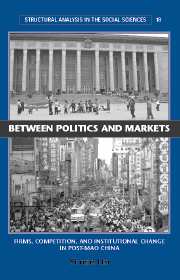Book contents
- Frontmatter
- Contents
- Tables and Figures
- Acknowledgments
- Introduction: Economic Market and Political Market
- 1 Chinese Industrial Enterprises: A Bird's-Eye View
- 2 Central Planning and Its Decline
- 3 The Rugged Terrain of Competition
- 4 Referee as Player: Menaces and Opportunities for Industrial Firms
- 5 Erosion of Authority Relations: A Tale of Two Localities
- 6 Favor Seeking and Relational Constraints
- 7 Competition, Economic Growth, and Latent Problems
- Conclusion
- Appendix A Statistical Data Sources
- Appendix B Methodological Note on Case Studies
- Bibliography
- Index
Appendix B - Methodological Note on Case Studies
Published online by Cambridge University Press: 15 July 2009
- Frontmatter
- Contents
- Tables and Figures
- Acknowledgments
- Introduction: Economic Market and Political Market
- 1 Chinese Industrial Enterprises: A Bird's-Eye View
- 2 Central Planning and Its Decline
- 3 The Rugged Terrain of Competition
- 4 Referee as Player: Menaces and Opportunities for Industrial Firms
- 5 Erosion of Authority Relations: A Tale of Two Localities
- 6 Favor Seeking and Relational Constraints
- 7 Competition, Economic Growth, and Latent Problems
- Conclusion
- Appendix A Statistical Data Sources
- Appendix B Methodological Note on Case Studies
- Bibliography
- Index
Summary
The Factories
The case study materials on the factories used in this study were mainly accumulated during 1988–96. I started the field research when I was a doctoral student. M y topic was the interaction between enterprise leaders and government officials. The selection of the factories was entirely based on access availability: M y acquaintances or friends in China introduced me to their acquaintances or friends holding important positions in factories (director, deputy director, Party secretary, deputy Party secretary, owner, and chief accountant). In addition to meeting with me, some of those enterprise leaders also helped to expand the pool of my interviewees by arranging meetings with their colleagues.
The disadvantage of this approach is apparent – it did not produce a random and representative sample. But a random and representative sample may generate little useful information (Babbie 1992: Chapter 11), especially when providing accurate answers to the questions posed by the researcher is perceived by the informants as having the potential of affecting their interests. A tradeoff often has to be made. M y use of the above method of information gathering was based on two related considerations. First, the usefulness of the information that I sought depended greatly on the willingness of the informants to reveal what they knew. Shorter social distance was conducive to increasing the likelihood of their cooperation. Second, granting an interview involves an opportunity cost. With the increase of uncertainty and competition, time had become increasingly precious for enterprise leaders.
- Type
- Chapter
- Information
- Between Politics and MarketsFirms, Competition, and Institutional Change in Post-Mao China, pp. 217 - 222Publisher: Cambridge University PressPrint publication year: 2001



